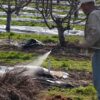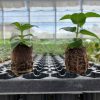
Often when our sales team talks with customers during a sales call or at a trade show, a customer will ask some great questions that are very deep into the science of mycorrhizae. I have decided to dedicate this article to answer some of those “Big” questions. I have solicited the help of two scientists from Mycorrhizal Applications to help answer these questions. Backgrounds on these two scientists are listed at the bottom of the article. Before answering these questions, it was quickly pointed out to me by one of the scientists, “That these are very big biological questions on which many scientists are currently working on… and for which there are no correct or definite answers.”
Can you explain the different types of mycorrhizae?
In nature, several types of mycorrhizae exist; they are commonly divided into two main groups; endomycorrhizae and ectomycorrhizae. The two types are differentiated by the fact that the hyphae of ectomycorrhizal fungi do not penetrate individual cells within the root, while the hyphae of endomycorrhizal fungi penetrate the cell wall and invaginate the cell membrane. Endomycorrhizae includes arbuscular mycorrhizae (AM), ericoid mycorrhizae (ERM), and orchid mycorrhizae (ORM). The most common type of mycorrhizae are AM, which represents symbiotic relationships between the majority (nearly 85%) of land plants, including several agricultural and horticultural plants, and Glomeromycota fungi. ERM is a partnership between Ericaceae plants, such as blueberries and rhododendron, and ascomycetous or basidiomycetous fungi. ORM is a symbiotic relationship between orchids and mostly basidiomycetous fungi; they occur exclusively in one plant family, Orchidaceae.
Ectomycorrhiza (ECM) is a partnership between mostly basidiomycetous fungi and various groups of woody plants, trees, and shrubs. ECM occurs predominantly on pines, spruces, firs, willows, oaks, and eucalyptus.
There are other, less commercially important types of mycorrhiza: ectendomycorrhizae (EEM), arbutoid mycorrhizae (ABM), and monotropoid mycorrhizae (MTM). EEM shows many of the characteristics of both AM and ECM and is restricted mostly to pine and spruce, and to a lesser extent larch. ABM and MTM are highly specialized types and occur in a few plant genera including Arbutus and Monotropa, respectively.
For more information detailing the mycorrhiza associated with most common horticultural and agricultural plants, I suggest you go to the Families and Genera resource.
What influences what type of mycorrhizae a plant associates with?
Simple answer: It might depend on the root architecture, most plants in the Ericaceae family have only one cortex cell layer so many AM cannot develop a relationship with them, only ERM can.
From the evolutionary point of view: Different AM genera have co-evolved with plants for several hundred million years, shaping ecological niches of various geographical dimensions and adapting to different biotopes. Since the plant ecological diversity is great in each biotope scientist believe that this co-evolution allowed the AM groups to interact with many (or most) of the plant species in that environment.
From the biological point of view: One of the very solid theories or ways of explaining the plant-fungus association is related to the plant’s nutritional status and needs. Plants can be schematized in a source = all those tissues producing complex carbon molecules such as sugars and lipids (leaves), and a sink = all tissues requiring those compounds/energy to grow or accomplish physiological cycles (root growth, flowering, seed development, etc.). The AM plays a role of sink (some calculated up to 15-20% of photosynthesized carbon goes to the fungus) but in most cases, the plant needs to interact with the AM because of the great amount of macro- and micronutrients it can get at a cost that is lower than expanding the root system). The plant-fungus exchanges are never leveling up to equality, in some cases the plant gets more and in others, the fungus playing the “cheater”, gets more for less in the exchange. For some authors, the nature and equilibrium of these exchanges is directly linked with the plant physiological needs (growth, reproduction, etc.), while for others the major variables are linked to environmental factors (soil conditions, precipitations, other microorganisms’ communities, etc.)
From the plant’s perspective interacting with multiple AM species might prevent or mitigate the negative effects that a “cheater” mycorrhiza can have. On the other side, it might help the plant retrieving most of the needed nutrients at a lower “price” by exchanging sugars and lipids with the AMF and getting the most from the water and nutrients it gets in return.
From the signaling point of view: Before the first contact and constantly during the mycorrhizal interaction, the plant and the fungus “speak” to each other exchanging chemical and molecular signals. Although the basic exchanges and steps to establish a functional interaction between them are shared among practically all plant species and AM groups, it is known that the communication between them is finely tuned and strictly dependent on both symbiont’s species. This might be an added explanation about why different AM types can associate with the same plant species or genera.
How do plants associate with more than one type of mycorrhizae?
Some plant species are capable of forming symbiotic relationships with more than one type of mycorrhizal fungi, even at the same time. Species of Aspen, Eucalyptus, Populus, or Salix have been reportedly formed symbiotic relationships with AM and Ectomycorrhizal fungi (ECM). The cellular structure of the root tissues allows the formation of both arbuscular mycorrhizae (AM) and ectomycorrhizae (ECM) in these plant taxa. The evolutionary role of this phenomenon is unclear. When they appear together, these fungi are normally in competition. The outcome of this competition could be mediated by chemicals of the fungal or host origin, mechanical barriers, competition for root carbohydrates, effects on rhizosphere communities, or other factors. Spatial heterogeneity in fungal inoculum adds another dimension to the competitive interactions in soils in natural ecosystems where AM and ECM occupy separate soil domains. Hyphae of some ECM are known to have the capacity to become locally dominant in soils (producing mats and strands). For wetland tree species, soil moisture can regulate the balance between AM and ECM in roots. Populus, Salix, and Aspen typically grow in flood plains which suggests that these plants with the ability to form both types of mycorrhizae might have a selective advantage in such habitats. These species generally fail to form ECM in poorly drained soils because most species of ECM are sensitive to aeration. In contrast, AM are more frequent in wet, flooded, or waterlogged conditions in these plant species.
Why are some plants non-mycorrhizal?
Mycorrhizal symbiosis is an almost ubiquitous interaction between plants and fungi; most plant species are capable of forming symbiotic relationships with mycorrhizal fungi. However, some plant taxa are described as characteristically non-mycorrhizal; they are incompatible with mycorrhizal fungi and do not form mycorrhizal relationships with any of the types discussed previously.
Until recently, mechanisms of mycorrhizal incompatibility have been debated mostly at the structural and physiological levels of the plant. However, most recent research provides an explanation for this phenomenon from an evolutionary genetics point of view. The current hypothesis proposes that all land plants were mycorrhizal in the beginning, allowing the colonization of land by plants. All these plants contained specific genes responsible for establishing and maintaining the symbiosis with mycorrhizal fungi. However, species that are currently known as non-mycorrhizal have lost their symbiotic capacity due to deletions of important symbiotic genes through evolution. The mechanism leading to the transition from a host to a non-host status is still unclear.
Among plants considered to be non-hosts for the widespread mycorrhizal fungi are various members of the families Proteaceae, Chenopodiaceae, Caryophyllaceae, and Brassicaceae, including several major agricultural and horticultural crops such as cabbage, broccoli, canola, radish, spinach, or carnation. Although mycorrhizal fungi can sometimes colonize these species under certain conditions, this colonization is, in most cases, functionally irrelevant (e.g., no arbuscule formation, or no nutrient uptake benefiting the plant).
Are there any parameters that indicate a significant symbiotic relationship between a plant and mycorrhiza?
A “significant symbiotic relationship” means an interaction that will cause a beneficial effect on plant development. If this is the case, I would approach the question based on the interaction between plant and fungus. Although the plant-fungus symbiosis is commonly associated ONLY to beneficial fungi. The term symbiosis refers to the interaction between two different organisms living in a close physical association. Between plants and fungi, we can have pathogenic interactions (parasitism), endophytic interactions (commensalism), and beneficial interactions (mutualism). In the last one, we have our dear spore-producing friends, mycorrhizae.
The separation between them is not always distinct and often there is a very delicate and no clear difference in the role of some symbionts. An example of this would be the complex Myco-heterotrophy relationship typical in some Orchid species. Within each category, there are weak boundaries between being completely “honest” and giving a fair amount of nutrients according to the carbon received and being “unfair” giving less or a “cheater” giving nothing or almost nothing back.
The complexity of this comes probably from the fact that each organism is trying to survive and closely manage its biological cycle resources. Growing, absorbing nutrients, and exchanging them with the other symbiont is an energy-consuming business that needs multi-level control to avoid being cheated upon. Clearly giving nothing and getting still something back is a winning scenario.
I would like to give a “Big” thanks to Dr. Leonardo Casieri and Dr. Jozsef Racsko for their help in trying to answer these “Big” biological questions.
Dr. Leonardo Casieri earned his Ph.D. in Biology and Biotechnology of Fungi from the University of Turin, Italy, and has considerable AMF post-graduate experience as a Post-Doctoral Fellow, Teaching Researcher, and Gene Family Expert. In short, Leonardo is a passionate mycologist and plant physiologist with over ten years of academic experience on arbuscular mycorrhizal fungi (AMF) and plant nutrition. He is now the Global Research Manager for Mycorrhizal Applications in the St. Louis laboratories. The Discovery of new AMF to be used for product development and implementing production lines are among his main goals.
Dr. Jozsef Racsko is currently a Technology Manager at Mycorrhizal Applications. Jozsef received his Master’s degree in Plant Physiology in 2003 from the University of Debrecen and got his Ph.D. degree in 2008 from the Univ. of Tasmania. Since then, Jozsef held various research, extension, and management positions at the Ohio State University and Valent BioSciences. After the acquisition of Mycorrhizal Applications by Valent BioSciences in 2015, he relocated to Southern Oregon as Technology Manager for mycorrhizal fungi. Jozsef now is responsible for research activities, product quality control, and technology development for both ecto- and endomycorrhizal fungi.
Article by: Blair Busenbark
Mycorrhizal Applications – Sales and Commercial Marketing Manager
July 6, 2020






